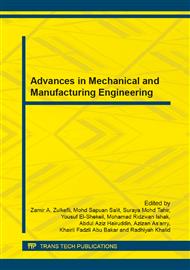[1]
ASHRAE. Thermal Environmental Conditions for Human Occupancy. ANSI-ASHRAE, Standard ASHRAE 55-1992, (1992).
Google Scholar
[2]
S. H. Sabarinah and Ahmad, Thermal Comfort and Building Performance of Naturally Ventilated Apartment Building in the Klang Valley: A Simulation Study. Proceedings of the Energy in buildings (sustainable symbiosis) Seminar, (2006).
Google Scholar
[3]
A. R. Samirah and K. S. Kannan, Special issue World Renewable Energy Vol. 8 (1-4) (1996) 264-266.
Google Scholar
[4]
H. B. Awbi and G. Gan, ASHRAE Journal Vol. 36(2) (1994) 17–21.
Google Scholar
[5]
K. W. D. Cheong, S. C. Sekhar, K. W. Tham and E. Djunaedy, Airflow Pattern in Air-Conditioned Seminar Room. Indoor Air 99. Proceedings of the Eighth International Conference on Indoor Air Quality and Climate, Vol. 2 (1999) 54–9.
DOI: 10.1111/j.1600-0668.2003.00191.x
Google Scholar
[6]
P. O. Fanger, Thermal Comfort: Analysis and Applications in Environmental Engineering McGraw-Hill, New York, (1970).
Google Scholar
[7]
K. C. Parsons, Human Thermal Environments, Taylor and Francis, London, (1993).
Google Scholar
[8]
S. Sharples and A. Malama, Building and Environment Vol. 32 (3) (1997) 237–243.
Google Scholar
[9]
H. H. Teo, Study of Thermal Comfort Conditions in Flatted Factories, Unpublished undergraduate Dissertation, School of Architecture, National University of Singapore, (1977).
Google Scholar
[10]
D. J. Croome, G. Gan and H. B. Awbi, Thermal Comfort and Air Quality in Offices, Proceedings of the Sixth International Conference on Indoor Air Quality and Climate, Vol. 6 (1993) 37–42.
Google Scholar
[11]
P. Taffe, Building and Environment Vol. 32 (2) (1997) 115–121.
Google Scholar
[12]
P. V. Nielsen, Flow in Air-Conditioned Rooms, Ph.D. Thesis, Technical University of Denmark, (1974).
Google Scholar
[13]
W. Lu, A. T. Howarth, N. Adam, S. B. Riffat, Building and Environment Vol. 31 (5) (1996) 417–423.
Google Scholar
[14]
R. A. Waters, Air Movement Studies, Clean Room Design Seminar, Institute of Mechanical Engineers, London, (1986).
Google Scholar
[15]
W.K. Chow, W.Y. Fung , Building and Environment Vol. 31 (4) (1996) 319–344.
Google Scholar
[16]
N.C. Markatos, The Computer Analysis of Building Ventilation and Heating Problems, Passive and Low Energy Architecture 1983, Proceedings of the Second International PLEA Conference, (1983).
DOI: 10.1016/b978-0-08-030581-3.50082-7
Google Scholar
[17]
P. J. Jones and P. E. O'Sullivan, Development of A Model to Predict Air Flow and Heat Distribution in Factories, SERC Final Report, (1987).
Google Scholar
[18]
Thompson, Fluent/Uns & Rampant 4. 2 User's Guide, Vol 1-4 (1997).
Google Scholar
[19]
Q. Chen, Building and Enviroment (1995).
Google Scholar


